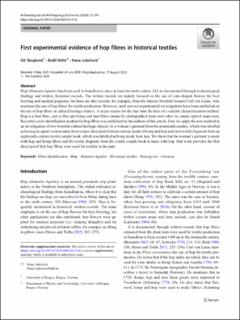| dc.contributor.author | Skoglund, Git | |
| dc.contributor.author | Holst, Bodil | |
| dc.contributor.author | Lukesova, Hana | |
| dc.date.accessioned | 2021-02-26T10:27:36Z | |
| dc.date.available | 2021-02-26T10:27:36Z | |
| dc.date.created | 2021-01-06T08:59:57Z | |
| dc.date.issued | 2020 | |
| dc.Published | Archaeological and Anthropological Sciences. 2020, 12 . | |
| dc.identifier.issn | 1866-9557 | |
| dc.identifier.uri | https://hdl.handle.net/11250/2730608 | |
| dc.description.abstract | Hop (Humulus lupulus) has been used in Scandinavia since at least the ninth century AD, as documented through archaeological findings and written, historical records. The written records are mainly focused on the use of cone-shaped flowers for beer brewing and medical purposes, but there are also records, for example, from the famous Swedish botanist Carl von Linne, who mentions the use of hop fibres for textile production. However, until now no experimental investigations have been published on the use of hop fibres in cultural heritage objects. A major reason for this has been the lack of a suitable characterization method. Hop is a bast fibre, just as flax and hemp and bast fibres cannot be distinguished from each other by simple optical inspection. Recently a new identification method for hop fibres was published by the authors of this article. Here we apply the new method in an investigation of two Swedish cultural heritage objects: (i) a woman’s garment from the nineteenth century, which was labelled as having an upper section made from coarse linen and a bottom section made of hemp and hop and (ii) a textile fragment from an eighteenth-century textile sample book, which was labelled as being made from hop. We show that the woman’s garment is made with hop and hemp fibres and the textile fragment from the textile sample book is made with hop. Our work provides the first direct proof that hop fibres were used for textiles in the past. | en_US |
| dc.language.iso | eng | en_US |
| dc.publisher | Springer | en_US |
| dc.rights | Navngivelse 4.0 Internasjonal | * |
| dc.rights.uri | http://creativecommons.org/licenses/by/4.0/deed.no | * |
| dc.title | First experimental evidence of hop fibres in historical textiles | en_US |
| dc.type | Journal article | en_US |
| dc.type | Peer reviewed | en_US |
| dc.description.version | publishedVersion | en_US |
| dc.rights.holder | Copyright 2020 The Author(s) | en_US |
| dc.source.articlenumber | 214 | en_US |
| cristin.ispublished | true | |
| cristin.fulltext | original | |
| cristin.qualitycode | 1 | |
| dc.identifier.doi | 10.1007/s12520-020-01171-6 | |
| dc.identifier.cristin | 1866052 | |
| dc.source.journal | Archaeological and Anthropological Sciences | en_US |
| dc.source.40 | 12 | |
| dc.source.pagenumber | 7 | en_US |
| dc.identifier.citation | Archaeological and Anthropological Sciences. 2020, 12, 214. | en_US |
| dc.source.volume | 12 | en_US |

